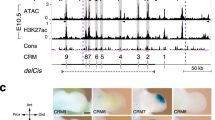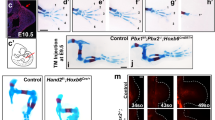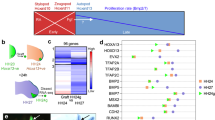Abstract
Most current models propose Sonic hedgehog (Shh) as the primary determinant of anteroposterior development of amniote limbs1. Shh protein is said to be required to direct the formation of skeletal elements and to specify digit identity through dose-dependent activation of target gene expression. However, the identity of genes targeted by Shh, and the regulatory mechanisms controlling their expression, remain poorly understood. Gli3 (the gene implicated in human Greig cephalopolysyndactyly syndrome) is proposed to negatively regulate Shh by restricting its expression and influence to the posterior mesoderm2,3,4. Here we report genetic analyses in mice showing that Shh and Gli3 are dispensable for formation of limb skeletal elements: Shh-/- Gli3-/- limbs are distally complete and polydactylous, but completely lack wild-type digit identities. We show that the effects of Shh signalling on skeletal patterning and ridge maintenance are necessarily mediated through Gli3. We propose that the function of Shh and Gli3 in limb skeletal patterning is limited to refining autopodial morphology, imposing pentadactyl constraint on the limb's polydactyl potential, and organizing digit identity specification, by regulating the relative balance of Gli3 transcriptional activator and repressor activities.
This is a preview of subscription content, access via your institution
Access options
Subscribe to this journal
Receive 51 print issues and online access
$199.00 per year
only $3.90 per issue
Buy this article
- Purchase on Springer Link
- Instant access to full article PDF
Prices may be subject to local taxes which are calculated during checkout




Similar content being viewed by others
References
Ingham, P. W. & McMahon, A. P. Hedgehog signaling in animal development: paradigms and principles. Genes Dev. 15, 3059–3087 (2001)
Masuya, H., Sagai, T., Wakana, S., Moriwaki, K. & Shiroishi, T. A duplicated zone of polarizing activity in polydactylous mouse mutants. Genes Dev. 9, 1645–1653 (1995)
Büscher, D., Bosse, B., Heymer, J. & Rüther, U. Evidence for genetic control of Sonic hedgehog by Gli3 in mouse limb development. Mech. Dev. 62, 175–182 (1997)
Wang, B., Fallon, J. F. & Beachy, P. A. Hedgehog-regulated processing of Gli3 produces an anterior/posterior repressor gradient in the developing vertebrate limb. Cell 100, 423–434 (2000)
Méthot, N. & Basler, K. Hedgehog controls limb development by regulating the activities of distinct transcriptional activator and repressor forms of Cubitus interruptus. Cell 96, 819–831 (1999)
Méthot, N. & Basler, K. An absolute requirement for Cubitus interruptus in Hedgehog signaling. Development 128, 733–742 (2001)
Aza-Blanc, P., Ramirez-Weber, F. A., Laget, M. P., Schwartz, C. & Kornberg, T. B. Proteolysis that is inhibited by Hedgehog targets Cubitus interruptus protein to the nucleus and converts it to a repressor. Cell 89, 1043–1053 (1997)
Pearse, R. V. & Tabin, C. J. The molecular ZPA. J. Exp. Zool. 282, 677–690 (1998)
Yang, Y. et al. Relationship between dose, distance and time in Sonic hedgehog-mediated regulation of anteroposterior polarity in the chick limb. Development 124, 4393–4404 (1997)
Lewis, P. M. et al. Cholesterol modification of Sonic hedgehog is required for long-range signaling activity and effective modulation of signaling by Ptc1. Cell 105, 599–612 (2001)
Chiang, C. et al. Manifestation of the limb prepattern: Limb development in the absence of Sonic hedgehog function. Dev. Biol. 236, 421–435 (2001)
Kraus, P., Fraidenraich, D. & Loomis, C. A. Some distal limb structures develop in mice lacking Sonic hedgehog signaling. Mech. Dev. 100, 45–58 (2001)
Sanz-Ezquerro, J. J. & Tickle, C. “Fingering” the vertebrate limb. Differentiation 69, 91–99 (2001)
Dai, P. et al. Sonic hedgehog-induced activation of the Gli1 promoter is mediated by GLI3. J. Biol. Chem. 274, 8143–8152 (1999)
Brewster, R., Lee, J. & Ruiz i Altaba, A. Gli/Zic factors pattern the neural plate by defining domains of cell differentiation. Nature 393, 579–583 (1998)
Brewster, R., Mullor, J. L. & Ruiz i Altaba, A. Gli2 functions in FGF signaling during antero-posterior patterning. Development 127, 4395–4405 (2000)
Shin, S. H., Kogerman, P., Lindstrom, E., Toftgard, R. & Biesecker, L. G. GLI3 mutations in human disorders mimic Drosophila Cubitus interruptus protein functions and localization. Proc. Natl Acad. Sci. USA 96, 2880–2884 (1999)
Sasaki, H., Nishizaki, Y., Hui, C.-c., Nakafuku, M. & Kondoh, H. Regulation of Gli2 and Gli3 activities by an amino-terminal repression domain: implication of Gli2 and Gli3 as primary mediators of Shh signaling. Development 126, 3915–3924 (1999)
Hui, C. C. & Joyner, A. L. A mouse model of Greig cephalopolysyndactyly syndrome: the extra-toesJ mutation contains an intragenic deletion of the Gli3 gene. Nature Genet. 3, 241–246 (1993)
Zúñiga, A. & Zeller, R. Gli3 (Xt) and formin (ld) participate in the positioning of the polarising region and control of posterior limb-bud identity. Development 126, 13–21 (1999)
te Welscher, P., Fernandez-Teran, M., Ros, M. A. & Zeller, R. Mutual genetic antagonism involving GLI3 and dHAND prepatterns the vertebrate limb bud mesenchyme prior to SHH signaling. Genes Dev. 16, 421–426 (2002)
Litingtung, Y. & Chiang, C. Specification of neuronal cell types in the ventral spinal cord is mediated by antagonistic interaction between Shh and Gli3. Nature Neurosci. 3, 979–985 (2000)
Caruccio, N. C. et al. Constitutive activation of Sonic hedgehog signaling in the chicken mutant talpid2: Shh-independent outgrowth and polarizing activity. Dev. Biol. 212, 137–149 (1999)
Martin, G. R. The roles of FGFs in the early development of vertebrate limbs. Genes Dev. 12, 1571–1586 (1998)
Zúñiga, A., Haramis, A.-P. G., McMahon, A. & Zeller, R. Signal relay by BMP antagonism controls the SHH/FGF4 feedback loop in vertebrate limb buds. Nature 401, 598–602 (1999)
Sun, X. et al. Conditional inactivation of Fgf4 reveals complexity of signalling during limb bud development. Nature Genet. 25, 83–86 (2000)
Fraidenraich, D., Lang, R. & Basilico, C. Distinct regulatory elements govern Fgf4 expression in the mouse blastocyst, myotomes, and developing limb. Dev. Biol. 204, 197–209 (1998)
Castilla, E. E. et al. Epidemiological analysis of rare polydactylies. Am. J. Med. Genet. 65, 295–303 (1996)
Qu, S. et al. Polydactyly and ectopic ZPA formation in Alx-4 mutant mice. Development 124, 3999–4008 (1997)
Radhakrishna, U. et al. The phenotypic spectrum of Gli3 morphopathies includes autosomal dominant preaxial polydactyly type IV and postaxial polydactyly type A/B. Am. J. Hum. Genet. 65, 645–655 (1999)
Acknowledgements
We thank Y.-F. Wang, R. Mernaugh and J. Lancman for technical assistance; R. Harland and B. Vogelstein for reagents; and S. Carroll and members of the Fallon laboratory for critical comments on the manuscript. This work was supported by grants from the National Institutes of Health to C.C. and J.F.F.
Author information
Authors and Affiliations
Corresponding authors
Ethics declarations
Competing interests
The authors declare that they have no competing financial interests.
Rights and permissions
About this article
Cite this article
Litingtung, Y., Dahn, R., Li, Y. et al. Shh and Gli3 are dispensable for limb skeleton formation but regulate digit number and identity. Nature 418, 979–983 (2002). https://doi.org/10.1038/nature01033
Received:
Accepted:
Published:
Issue Date:
DOI: https://doi.org/10.1038/nature01033
This article is cited by
-
Suppression of apoptosis impairs phalangeal joint formation in the pathogenesis of brachydactyly type A1
Nature Communications (2024)
-
Hippo signaling activates hedgehog signaling by Taz-driven Gli3 processing
Cell Regeneration (2023)
-
Regenerative Engineering of a Limb: From Amputation to Regeneration
Regenerative Engineering and Translational Medicine (2023)
-
Membrane protein trafficking in the anti-tumor immune response: work of endosomal-lysosomal system
Cancer Cell International (2022)
-
Evolutionary genetics of flipper forelimb and hindlimb loss from limb development-related genes in cetaceans
BMC Genomics (2022)
Comments
By submitting a comment you agree to abide by our Terms and Community Guidelines. If you find something abusive or that does not comply with our terms or guidelines please flag it as inappropriate.



